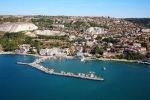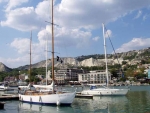BALCHIK
At 17 km from Kavarna and 30 km north of Varna, is situated the Balchik
city. One of the most beautiful cities on the Bulgarian Black sea
coast, the city is situated amphitheatrically before the sea. The
population is 14,000.
In the very plateau where the Balchik city is located today, was a Thracian village. In 5th century BC Greek settlers occupied this area. They were encharmed by the The fat land was cropped of vineyards and local people produced wonderful wine. The Greeks worshiped the god Dionisii and their coin bears the icon. In the honour of that God the town was called Dionisipolis.
The city became an important centre with wealthy attraction. After a round of invasions and destructions by the Romans, the city gradually declined. During the medieval period, the city became autonomous by its conqueror Boyar Balchik, and the city assumed its name Balchik.
After 1912, when Bulgaria lost the Balkan war, the city was incorporated into Romania. After then, the Romanian Queen named Maria visited the city frequently and she built a holiday villa with a botanical gardens. This area attracted Romanian aristocrats, due to its mineral water and Karst.
After 1940, the city of Balchik was reincorporated into Bulgarian territory. Today the city attracts tourists with its unique ancient houses and streets, which preserve the ancient nature. Every street leads to the sea coast and all year round the city boost of many tourists. Among the city attractions are: ethnographical museums, Old Turkish Mosque and the church St. Nicholay.
The area that features most tourists is the queen’s palace with the botanical garden, and this is the biggest botanical garden in the Balkan and the second in the world. The garden features seldom plants.
The city features many hotels of different classes.
The beach very close to the city is 4 km long. The port is used for middle class voyage.
At 4 km east of the city is situated the area called Tuzlata, renown for its medicinal mud, recommended for bone associated diseases. There is a big balneological center with camping, bungalow and hotels.
In the city of Balchik, there are minerals spring with temperature of about 31°C used for internal cure.
In the very plateau where the Balchik city is located today, was a Thracian village. In 5th century BC Greek settlers occupied this area. They were encharmed by the The fat land was cropped of vineyards and local people produced wonderful wine. The Greeks worshiped the god Dionisii and their coin bears the icon. In the honour of that God the town was called Dionisipolis.
The city became an important centre with wealthy attraction. After a round of invasions and destructions by the Romans, the city gradually declined. During the medieval period, the city became autonomous by its conqueror Boyar Balchik, and the city assumed its name Balchik.
After 1912, when Bulgaria lost the Balkan war, the city was incorporated into Romania. After then, the Romanian Queen named Maria visited the city frequently and she built a holiday villa with a botanical gardens. This area attracted Romanian aristocrats, due to its mineral water and Karst.
After 1940, the city of Balchik was reincorporated into Bulgarian territory. Today the city attracts tourists with its unique ancient houses and streets, which preserve the ancient nature. Every street leads to the sea coast and all year round the city boost of many tourists. Among the city attractions are: ethnographical museums, Old Turkish Mosque and the church St. Nicholay.
The area that features most tourists is the queen’s palace with the botanical garden, and this is the biggest botanical garden in the Balkan and the second in the world. The garden features seldom plants.
The city features many hotels of different classes.
The beach very close to the city is 4 km long. The port is used for middle class voyage.
At 4 km east of the city is situated the area called Tuzlata, renown for its medicinal mud, recommended for bone associated diseases. There is a big balneological center with camping, bungalow and hotels.
In the city of Balchik, there are minerals spring with temperature of about 31°C used for internal cure.




